On a bright Saturday, late in the morning, Steve and I decided to hike up the volcanic cone that we could see from his house, located just next to Waikiki. We packed stuff that would unwittingly come in handy later that day: a flashlight, water bottles, camera, a hat, a first aid kit, and a permanent marker among other things.
The shot below shows the view that we came upon, after overhearing some man talking to a friend about calling 911. It sounded like he was talking about someone that was elsewhere (he mentioned that they were located at least 30 minutes away from help), so we continued on, and took a short rest here:
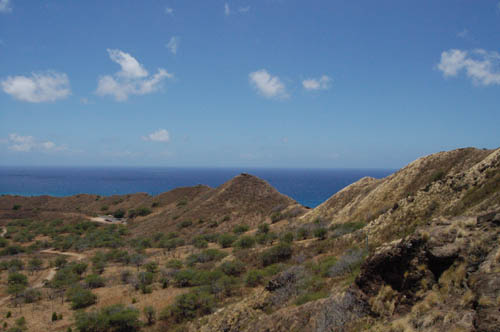
While starting back on the trail, the old man came up to us asking if we spoke Japanese, because there was a girl near the top of the mountain that couldn't speak English and was in critical condition. I told him that I could, and after a short briefing he sent us up before him on a sprint to the summit.
It took about ten minutes of passing people through narrow tunnels bored through the mountain and narrow switchbacks to reach the girl. The old man had told us that she was unconscious, and when we got there, a physician informed us that they had given her candy because they thought she was going into diabetic shock.
When we arrived, she was regaining consciousness, and I was told that she had hit her head. I asked the girl what her name was and where she was, and she was able to answer both questions. A physician who was also there asked me to interpret questions that the paramedics would need when they arrived:
Does she have diabetes? After being back for 2 years, I have had little opportunity to practice, so my Japanese was a bit rusty. Luckily, it seemed to come back to me, but I had no idea how to say "diabetes". Instead, I had to ask "Does she experience problems if she eats too much or not enough sugar?".Did she hit her head?
Initially the answer was "yes" from the boyfriend. The answer on this changed later on, as the boyfriend thought she hit her head, but the girl didn't, and didn't have any visible marks, swelling, or discoloration on her head.Can she wiggle her toes?
She was able to.Does she feel dizzy?
She did at first, but after drinking some water and resting in the cool tunnel, she was able to regain her strength.Is she pregnant?
No, she was not.Does she have any pre-existing medical conditions that we should know about?
No.Is she taking medication?
No.
I had to ask her these questions three times: once with the physician (who decided to leave her with us after he assessed her condition as stable), once with the firefighters who met us later on, and once at the ambulance at the base of the mountain. Her symptoms indicated that she was suffering from heat exhaustion, and her condition gradually improved in the shade.
After she said that she could make it down the hill with her boyfriend, Steve and I helped her down the trail, and met a team of firefighers a third of the way down. Once again, I asked these questions, and they made it clear that they wanted to airlift her out. It was my job to explain what was going to happen and why, but more importantly to reassure the couple.
It turns out that getting airlifted out of Diamond Head is free, and that there are 2 delivery systems. One rig uses a gurney-like platform where the person being rescued lays down. The other one, the Bill Pugh, is the one that you can see in the pictures.
The girl was afraid of riding in the rig, so we told her that a firefighter would be riding with her, and that she could decline treatment when we got the the ambulance. After ten minutes, the chopper showed up, dropped off their rescue team on a tiny pinnacle, and swung around to pick her up:
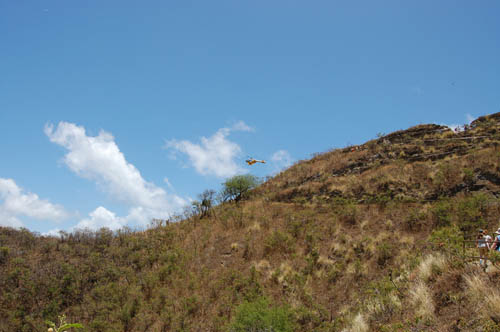
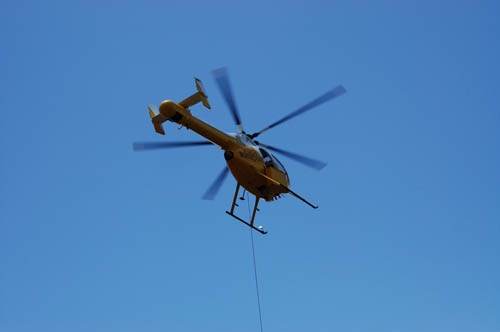
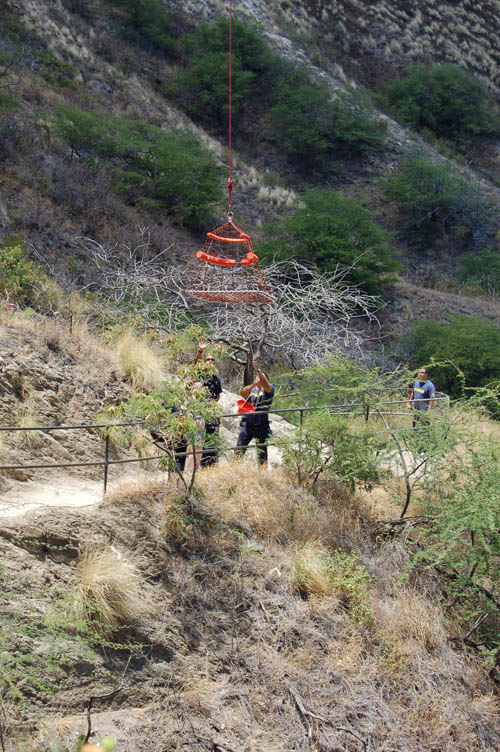

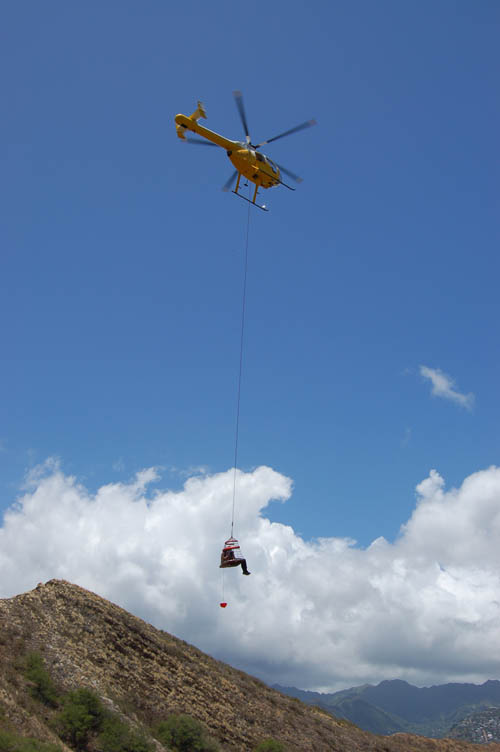
A firefighter accompanied her on her ride down to the bottom of the mountain to an ambulance awaiting their arrival. When we got there, I asked the questions a third time, and stuck around until they had finished their business. After declining treatment, the girl and her boyfriend thanked everyone and we decided not to climb Diamond Head a second time. We had come so close to the top and didn't quite reach the summit, but at that point it didn't seem as interesting.
We met the old man shortly after. Royce, it turned out, used to be a local firefighter, and he just had happened to be hiking the trail, and called in the rescue. Of all the people he passed on the trail, I was the only one who could interpret.
Usually, when I go on a short hike, I don't carry so much stuff with me, but on that day, we used them all, except for the First-Aid pack (ironic, huh?). We let her use our water to cool off, used the flashlight to assess her condition in the tunnel, Steve lent her a hat to keep her cool, and the marker to write down her medical condition to pass to the EMTs at the bottom of the hill. Things just seemed to work out well for the couple, it seemed.
As we were leaving, we saw them waiting at the bus stop, and stopped to give them a ride back to their hotel. They were from Wakayama, it turned out, on a Hawaiian vacation. In the air conditioned car, they were a lot more relaxed, and asked to take a picture with us:
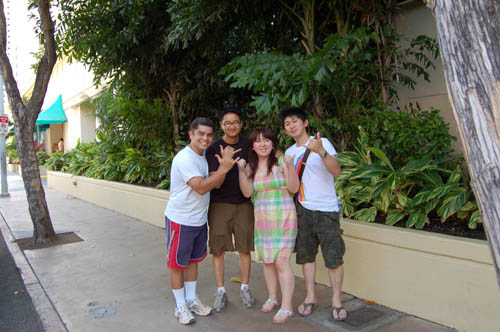
It seems that things like this happen when I go traveling, and when I hang out with Steve. I have good luck meeting the right people, being in an interesting place at the right time, and just having fun or profound experiences. Maybe it's a sign that I should do both of these things more frequently...
Seems like wherever Adam is, injury follows.
What a neat way to see Diamond Head, a free copter ride! Great that you and Steve got to play Rescue Rangers!
Chris,
Let me put forth a minor adjustment to your observation. Wherever Chris and Adam went during their days at UCSB, injury, usually with hilarious results, followed them.
Let's hope that we don't have THAT much fun anymore. A massive enough dosage of anything can render normally harmless things lethal...
Plus...we left the peroxide bottle at home.